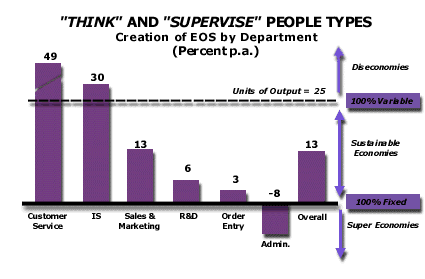Analysis 60: Employees Economies of Scale by Department
EXHIBITS:

- Audio Tip #191: Sustainable Economies of Scale
- Audio Tip #193: The Types of People in a Functional Cost Organization
| HOW TO INTERPRET THE ANALYSIS: This exhibit shows the Economies of Scale for the “Think” and “Supervise” people in the functional cost departments of a company in a fast growing industry. The analysis focuses on “Think” and “Supervise” people since they cost considerably more than “Do” people. In this company, units of Output are growing at 25% a year, a very fast growth rate. Despite this rapid growth, two of the departments are creating Dis-economies of Scale with “Think” and “Supervise” people. Those departments are Customer Service and IS. Both of those departments are growing “Think” and “Supervise” people faster than unit sales are growing. The company is becoming less cost effective in these two departments as the business grows. The next three departments: Sales and Marketing, R and D, and Order Entry are creating sustainable Economies of Scale. They are growing their “Think” and “Supervise” people at rates below the growth rate of unit sales. Finally, the Admin department is creating Super Economies of Scale in “Think” and “Supervise” people. This is not a sustainable situation over the long term. The Admin department is shrinking in size as units sales grow. Eventually, this situation must reverse.
PURPOSE: The company uses this analysis to ensure unit costs fall as volume grows by focusing on the “Think” and “Supervise” FTEs in each functional cost organization. APPROACH: “Think” and “Supervise” employees cost significantly more than “Do” employees. Effective efforts at teh creation of Economies of Scale will focus more attention on these more valuable, and more costly, types of employees. This analysis should evaluate each SG&A department’s “Think” and “Supervise” people for the creation of Economies of Scale. This refinement of Analysis 58, the earlier departmental Economies of Scale analysis, improves the company’s measurement of Economies of Scale on those employee types that have the greatest leverage on the cost of structure. These employees also should have the highest rates of economies of scale creation. If the company’s physical cost structure grows more slowly than does its Output, it creates sustainable Economies of Scale. Sustainable Economies of Scale happen whenever the growth rate in head count is somewhere between zero and the rate of growth in units of sale. Dis-economies of Scale occur whenever head count rises at a faster rate than does the rate of unit sales growth. Dis-economies of Scale would imply that the company becomes less cost effective as it grows its business. Super-economies of Scale occur when an organization’s head count actually declines as the company adds volume. Super-economies of Scale are always temporary. They usually occur when the company has implemented a major change in technology, which produces a significant reduction in force for one or several departments. Super-economies can also occur when departments are de-centralized to other parts of the organization. These kinds of Super-economies are merely accounting changes, rather than true Economies of Scale. Creation of Economies of Scale enable the company both to reduce its unit costs as it grows, and to improve its cost position compared to competitors, as long as the company grows market share. Return to Diagnose Costs: Measuring Economies of Scale by People Type |
| Recommended Reading |
| For a greater overall perspective on this subject, we recommend the following related items:
Analyses:
Symptoms and Implications:
Perspectives: Conclusions we have reached as a result of our long-term study and observations.
|
